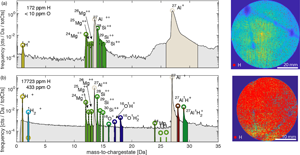Crossref Citations
This article has been cited by the following publications. This list is generated based on data provided by
Crossref.
Gemma, Ryota
Al-Kassab, Talaat
and
Pundt, Astrid
2022.
Deuterium Distribution in Fe/V Multi-Layered Films.
Molecules,
Vol. 27,
Issue. 22,
p.
7848.
Felfer, Peter
Ott, Benedict
Heller, Martina
Weiser, Martin
and
Monajem, Mehrpad
2022.
Imaging of hydrogen in metals using an atom probe with ultra-low hydrogen background.
Microscopy and Microanalysis,
Vol. 28,
Issue. S1,
p.
1648.
McCarroll, Ingrid E.
Daly, Luke
White, Lee F.
and
Cairney, Julie M.
2022.
Atom probe tomography and correlative microscopy: Key techniques for future planetary science studies.
MRS Bulletin,
Vol. 47,
Issue. 7,
p.
696.
Jürgensen, J.
and
Pohl, M.
2023.
Impact and Detection of Hydrogen in Metals.
HTM Journal of Heat Treatment and Materials,
Vol. 78,
Issue. 5,
p.
257.
Tunes, Matheus A.
Uggowitzer, Peter J.
Dumitraschkewitz, Phillip
Willenshofer, Patrick
Samberger, Sebastian
da Silva, Felipe C.
Schön, Cláudio G.
Kremmer, Thomas M.
Antrekowitsch, Helmut
Djukic, Milos B.
and
Pogatscher, Stefan
2024.
Limitations of Hydrogen Detection After 150 Years of Research on Hydrogen Embrittlement.
Advanced Engineering Materials,
Maillet, Jean-Baptiste
Da Costa, Gerald
Klaes, Benjamin
Bacchi, Christian
Normand, Antoine
Vaudaulon, Charly
and
Vurpillot, François
2024.
In Situ Pulsed Hydrogen Implantation in Atom Probe Tomography.
Microscopy and Microanalysis,
Paudel, Binod
Dhas, Jeffrey A.
Zhou, Yadong
Choi, Min-Ju
Senor, David J.
Chang, Chih-Hung
Du, Yingge
and
Zhu, Zihua
2024.
ToF-SIMS in material research: A view from nanoscale hydrogen detection.
Materials Today,
Vol. 75,
Issue. ,
p.
149.
Mayweg, David
Eriksson, Johan
Sattari, Mohammad
and
Thuvander, Mattias
2024.
Limits of hydrogen analysis by atom probe tomography targeting Zr(Fe,Cr)2 second phase particles in Zr-based fuel cladding from reactor operation.
Journal of Nuclear Materials,
Vol. 601,
Issue. ,
p.
155343.
Ott, Benedict
Heller, Martina
Monajem, Mehrpad
and
Felfer, Peter
2024.
Miniaturized gas exposure devices for atom probe experiments.
Microscopy Research and Technique,
Vol. 87,
Issue. 9,
p.
2113.
Heller, Martina
Ott, Benedict
Dalbauer, Valentin
and
Felfer, Peter
2024.
A MATLAB Toolbox for Findable, Accessible, Interoperable, and Reusable Atom Probe Data Science.
Microscopy and Microanalysis,
Heller, Martina
Ott, Benedict
and
Felfer, Peter
2024.
Compensating Image Distortions in a Commercial Reflectron-Type Atom Probe.
Microscopy and Microanalysis,
Gault, Baptiste
Saksena, Aparna
Sauvage, Xavier
Bagot, Paul
Aota, Leonardo S
Arlt, Jonas
Belkacemi, Lisa T
Boll, Torben
Chen, Yi-Sheng
Daly, Luke
Djukic, Milos B
Douglas, James O
Duarte, Maria J
Felfer, Peter J
Forbes, Richard G
Fu, Jing
Gardner, Hazel M
Gemma, Ryota
Gerstl, Stephan S A
Gong, Yilun
Hachet, Guillaume
Jakob, Severin
Jenkins, Benjamin M
Jones, Megan E
Khanchandani, Heena
Kontis, Paraskevas
Krämer, Mathias
Kühbach, Markus
Marceau, Ross K W
Mayweg, David
Moore, Katie L
Nallathambi, Varatharaja
Ott, Benedict C
Poplawsky, Jonathan D
Prosa, Ty
Pundt, Astrid
Saha, Mainak
Schwarz, Tim M
Shang, Yuanyuan
Shen, Xiao
Vrellou, Maria
Yu, Yuan
Zhao, Yujun
Zhao, Huan
and
Zou, Bowen
2024.
Towards Establishing Best Practice in the Analysis of Hydrogen and Deuterium by Atom Probe Tomography.
Microscopy and Microanalysis,
Maillet, Jean-Baptiste
Da Costa, Gerald
Bacchi, Christian
and
Vurpillot, François
2024.
In-situ Hydrogen Implantation in Atom Probe Tomography and Investigation of Hydrogen Embrittlement.
Microscopy and Microanalysis,
Vol. 30,
Issue. Supplement_1,




